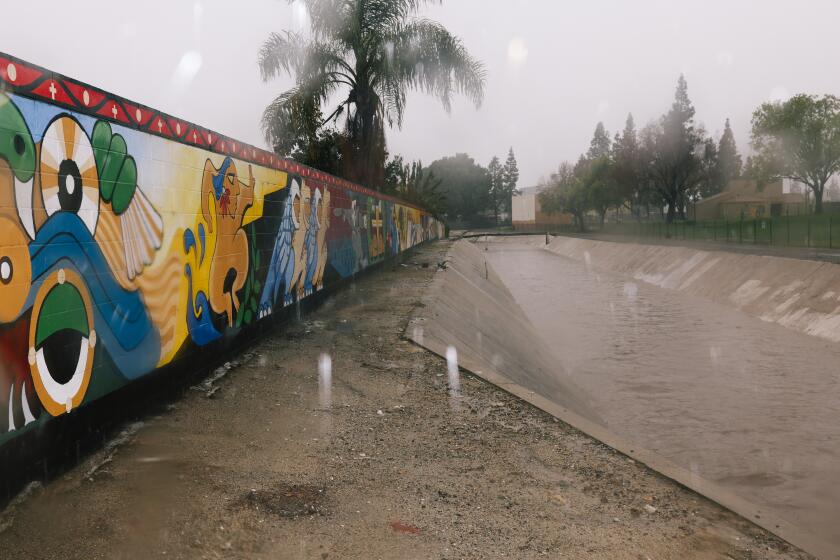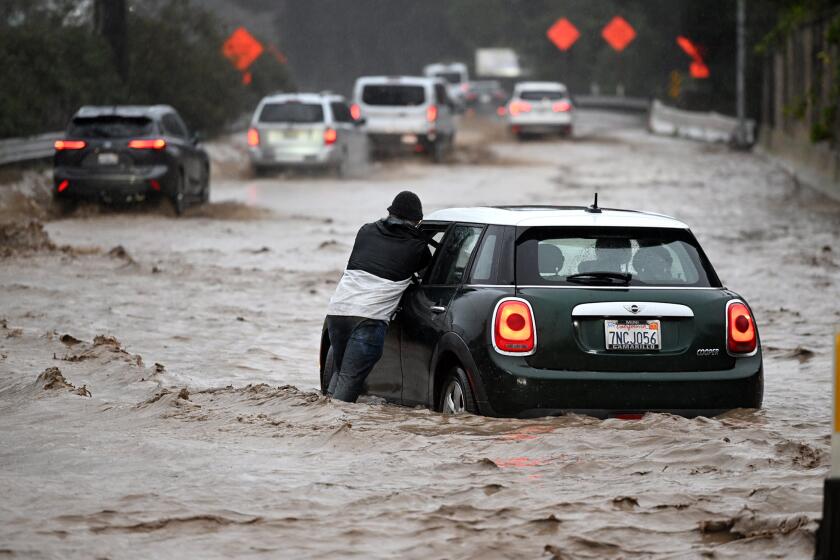California has lots of catching up to do on flood management — with or without climate change

- Share via
SACRAMENTO — When Leland Stanford became California’s governor in 1862, he needed a rowboat to carry him to the Capitol to be sworn in.
Sacramento’s streets were flooded. In fact, much of California was. A 300-mile-long lake was created in the Central Valley from near Bakersfield to Red Bluff. At least 4,000 people were killed.
It was the largest flood in the recorded history of California, Nevada and Oregon, dumping 10 feet of water on this state over a 43-day period.
The Great Flood of 1862 followed a 20-year drought.
And it occurred half a century before gasoline-burning automobiles began spewing greenhouse gases into the atmosphere, exacerbating human-caused global warming.
Gov. Gavin Newsom seems, in every other sentence, to blame the intensity of our current storms — or any drought or wildfire — on climate change. We’re getting drier and wetter and the cycles are becoming more frequent, he and experts warn.
OK, I’m no climatologist. But I do read history. And you can acknowledge history without being a climate denier. Burning fossil fuel has warmed the planet and appears to have mucked up our climate. But we’d still suffer terrible droughts and disastrous storms even if all the energy we used was carbon free.
Cycles of drought and flooding have been the California way — nature’s way — for eons. There were many droughts and megafloods in California prior to the industrial revolution — before we packed nearly 40 million people into the state, making these events even more disastrous to humans.
And, of course, there were several catastrophic floods in the last century before global warming became acute.
Times columnist Gustavo Arellano recently wrote about the Great Flood of 1938.
“What Southern California has weathered so far this January has been bad but nowhere near as destructive as 1938,” he reminded. All the basin’s major rivers overflowed their banks. At least 87 people were killed.
At Christmastime in 1955, floods inundated much of Northern California, killing more than 60 people. At least 42 died around Yuba City and Marysville when the Feather River burst its banks.
Southern California’s deadliest flood happened 85 years ago. We visit its few monuments to learn about the devastation left behind.
“California has lots of extremes. We’ve always had more wet years and drier years than any part of the country,” Jay Lund, vice director of the UC Davis Center for Watershed Sciences, once told me. “Every year we’re managing for drought and for floods, and we always will.”
Yes, and we’ve got lots of catching up to do on flood management with or without climate change.
The 1955 flooding motivated just enough Northern California legislators and voters eager for flood control to approve new Gov. Pat Brown’s then-controversial California Water Project in 1960. It included the huge Oroville Dam on the Feather River.
But the state has added little to its once-prized water system since then. Meanwhile, the population has more than doubled.
One failure is we’re not capturing and storing nearly as much floodwater as we should. The primary example is in the Sacramento-San Joaquin River Delta, the source of drinking water for 27 million Californians and irrigation for 3 million acres.
Ideally, we’d be grabbing big pools of nature’s gift and storing it for use in dry years. Instead, it escapes through San Francisco Bay and flows into the ocean.
One immediate reason we’re capturing less water than we could is a regulation agreed to by the former Trump administration.
Under it, the “first flush” of each season’s major storm is reserved for the bay. For two weeks, state and federal pumps at the southern end of the delta have been permitted to pump at only about half capacity.
President Biden will be visiting California this week following the winter storm that left the state with closed roads, freezing temperatures and a Venture County city evacuated.
The main reason is to protect endangered fish. Aggressive pumping reverses San Joaquin River flow, sucking endangered tiny smelt and little salmon into the pumps or mouths of large predator fish. But fish aside, the reverse flows draw in salt water from the bay. And that gets pumped south into Southern California reservoirs.
“That’s why we’re so focused on the delta tunnel. It’s going to allow us to pump large amounts of water during big winter storms without an environmental impact,” says Wade Crowfoot, secretary of the state Natural Resources Agency.
Fresher Sacramento River water from the north delta would be siphoned into a 45-mile-long, 39-foot-wide tunnel ending near the southbound aqueducts. If it had been in place, Crowfoot estimates that an additional 131,000 acre-feet of floodwater could have been captured during the current storm as of late last week.
But small delta communities, local farmers and environmentalists worry that if the tunnel existed, water grabbers — meaning San Joaquin agriculture and L.A. — wouldn’t just be taking stormwater. They’d also be seizing water during dry summers and droughts, leaving the delta saltier.
All that must be negotiated and litigated. If it’s ever built, the $16-billion project probably couldn’t be operational until at least 2040.
There also needs to be more storage room for floodwater. There’s a perpetual cry for additional costly dams. But we’re already dammed to the brim. There are nearly 1,500 dams in California. Practically every good site has been used.
But one sensible dam project is noncontroversial and headed for construction. It’s Sites in Colusa County, an off-stream reservoir that would hold 1.5 million acre-feet of water siphoned off the nearby Sacramento River. Construction on the $4.5-billion project could begin in 2025.
Some existing dams, including San Luis in Merced County and Los Vaqueros in Contra Costa County, probably will be expanded.
But the future of storage is underground in depleted aquifers. That’s a major focus of state and local governments.
Meanwhile, even with climate change, Newsom didn’t need to row a skiff to his recent second inauguration at the Capitol. He was driven to the outdoor ceremony in a big SUV as storm clouds briefly parted.
More to Read
Sign up for Essential California
The most important California stories and recommendations in your inbox every morning.
You may occasionally receive promotional content from the Los Angeles Times.











